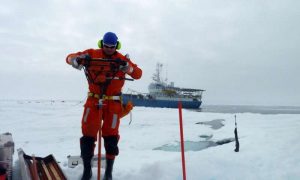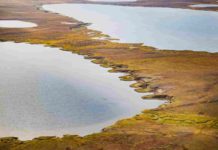
Credit: Marcel Nicolaus
Every school child knows that ice melts in the summer and freezes in the winter. But it turns out that the process isn’t that simple in the Arctic, where one type of sea ice structure, called an ice ridge, can actually get stronger in the summer due to melting.
Think of it as Lazarus ice: instead of melting away to nothing in the heat of the Arctic summer, some ice ridges actually come back to life like Lazarus from the Bible, and are stronger at the end of the summer.
Scientists predict that ships will be able to sail directly over the North Pole by 2050. The Northern Sea Route, which extends from the North Atlantic along the northern coast of Arctic Russia to Asia, reduces the shipping distance between Europe and Asia by as much as 40 per cent compared to travel via Suez Canal. While low oil prices have reduced the traffic on this route to just 18 ships in 2015, in 2013 71 ships traveled the route with more than 1.3 million tonnes of cargo.
In spite of the variation in numbers, the trend is clear. Naval engineers need the most comprehensive information they can get to design ships and ocean structures for a future that can include travel through polar seas. And that’s where the research of Aleksey Shestov, a postdoc with the Norwegian University of Science and Technology’s Sustainable Arctic Marine and Coastal Technology Programme, or SAMCoT, comes in.
Icebergs rare, ice ridges common
Shestov studies ice ridges, big wrinkles in sea ice that form when ice floes slam together. What makes ice ridges of particular interest for both ships and offshore structures like oil platforms is that they are far more common than icebergs.
“When you talk about icebergs (the probably of a collision) is a 100-year event,” which means that it has only a 1 percent chance of happening in any one year, Shestov says. In contrast, ice ridges need to be factored into ship and offshore structure designs “because you expect to encounter ice ridges every day.”
Shestov is specifically interested in understanding the complicated freezing processes that take place inside an ice ridge. The way an ice ridge freezes together over time partly controls how big and strong it can get.
Shestov had an unusual opportunity to look at what happens to ice ridges during the summer last year when he spent part of May and much of June aboard the Lance polar research vessel. The Lance spent six months in the Arctic waters north of Svalbard for a multinational research project coordinated by the Norwegian Polar Institute to study young, or first-year sea ice.
Salinity is key
If you could cut an ice ridge in half, what you would see would be the ridge, above water, which researchers call the sail, and a protrusion underwater, which researchers call the keel. The flat sea ice around the ridge itself is called the level ice. The core of the ridge is made up of jumbled blocks of sea ice that smashed together and then were frozen solid.
The blocks of ice that form the centre of the ridge have holes between them, which not surprisingly are filled with sea water. Sea water, being salty, freezes at a lower temperature than fresh water, so it can remain liquid even as it is entombed inside the core of the ice ridge.
During the winter, ice ridges freeze hard and they can grow, as atmospheric cooling causes more and more ice to form around the ridge, Shestov said. As spring comes with its warmer temperatures, ice ridges melt, both from above and from below. But here’s where the surprise comes in.
As the ice ridge melts from the top, puddles of relatively fresh water form around the sail of the ridge, and that melt water can trickle into the core of the ridge, causing the briny sea water that is trapped in between the jumbled blocks inside the ridge to become less salty.
“This dribbling down of fresh water helps consolidate the ridge, because when it replaces the salt water, it can extract the cold from the ice in the ridge and freezes,” Shestov says. “So the ice ridge actually consolidates during the summer. It’s still melting, but there is also freezing inside the ridge.”
That means ice ridges can be stronger than they might seem given their size, because of this interaction between the ice and fresh water.
First-hand experience of thawing
While Shestov has a background as a physicist and mathematician, his affiliation with SAMCoT and his work at UNIS, the University Centre in Svalbard, has led him to spend more and more time out in the field, measuring sea ice ridges and developing physical models of how they grow and thaw.
Sometimes this work takes a surprising turn, as it did during the last few days of the N-ICE cruise last June. At that point, the Lance was anchored to a thin ice floe that was several kilometers across, where Shestov and a number of other scientists were making measurements.
Everyone knew the ice floe would melt. That was part of the reason they had anchored up to the floe, so that they could measure what happened with temperatures and salinities as the ice floe melted away. But when the ice floe finally broke up, it happened extremely quickly.
“Suddenly cracks appeared by the ship. We were right by the ice edge, and exposed to the dynamics of the open sea. A small swell was all it took,” wrote Mats Granskog, chief scientist for the cruise on a blog post for the project. “Within minutes our floe had disintegrated into smaller floes, no bigger than some tens of meters in size.”
Stay calm and keep filming
Shestov watched with fascination as the floe broke up, with much of his equipment still out on the ice, where he had originally planned to continue his work. Once the ice began to break up, however, he knew the ice would break up relatively fast.
“I was surprised that some of my colleagues were actually planning to work again, after we saw part of the floe break up. They thought that all we needed to do was to adjust the mooring line and continue, but when the floe began to break up, it was a clear signal that the swell had arrived and it was time to hurry up.
It took at least two hours to pluck all the scientific equipment off of the ice, which the crew managed to do without losing anything. Shestov made a video of the experience. “I just try to stay calm and do the work that is needed,” he said.
You can see the video he made of the ice breakup at:
Reference:
Thermodynamic consolidation of ice ridge keels in water at varying freezing points. AS Shestov and AV Marchenko. Cold Regions Science and Technology 121:1-10. January 2016
The consolidation of saline ice blocks in water of varying freezing point: Laboratory experiments and computer simulations. AS Shestov and AV Marchenko. Cold Regions Science and Technology 122:71-79. February 2016
Note: The above post is reprinted from materials provided by Norwegian University of Science and Technology.










